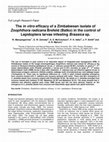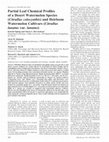Papers by Gloria McCutcheon
OBJECTIVE: To increase the annual harvest of steelhead from 25,000 to 50,000........................ more OBJECTIVE: To increase the annual harvest of steelhead from 25,000 to 50,000........................ 3 Problem 1: Return to creel is inadequate to reach the objective of 50,000 fish harvested............ 3
CRC Press eBooks, Jul 17, 2007
2000 Proceedings Beltwide Cotton Conferences, San Antonio, USA, 4-8 January, 2000: Volume 2., 2000

African Journal of Microbiology Research, Jul 18, 2011
The use of microbes in pest control is an important aspect of integrated pest management (IPM). A... more The use of microbes in pest control is an important aspect of integrated pest management (IPM). A Zimbabwean isolate of the fungal entomopathogen Zoophthora radicans was tested for efficacy in the control of Brassica infesting lepidopteran larvae. Z. radicans caused 98.68% mortality on small (1 st-2 nd instar) diamondback moth (Plutella xylostella L.) larvae and 21.34% mortality on large (3 rd-4 th instar) diamondback moth (DBM) larvae 6 days after treatment. Z. radicans was not effective against larvae of Helicoverpa armigera, webworm (Hellula undalis), cabbage moth (Crocidolomia sp.) and cabbage looper (Trichoplusia ni). There was no significant difference (p > 0.05) in adult Cotesia plutellae emergence from cocoons treated with Z. radicans and cocoons sprayed with water. There was 95% emergence of C. plutellae adults from cocoons treated with Dimethoate 40 EC. No adults of C. plutellae emerged from cocoons treated with Carbaryl 75 WP, Malathion 25 WP and Malathion 50 EC. The study showed that Z. radicans was effective against early instar DBM larvae and did not have adverse impacts on the emergence of C. plutellae adults from cocoons and Diaeretiella rapae adults from aphid mummies.

African Journal of Biotechnology, May 31, 2006
Reports on the emergence of insect resistance to Bacillus thuringiensis delta endotoxins have rai... more Reports on the emergence of insect resistance to Bacillus thuringiensis delta endotoxins have raised doubts on the sustainability of Bt-toxin based pest management technologies. Corporate industry has responded to this challenge with innovations that include gene pyramiding among others. Pyramiding entails stacking multiple genes leading to the simultaneous expression of more than one toxin in a transgenic variety. Questions have been raised on the sustainability of gene pyramiding since the use of insecticide mixtures has shown that cross resistance and/or multiple resistance can render such strategies to be less effective in the long term. Current theoretical and practical evidence in insect population genetics suggest that gene pyramiding cannot be sustained as a resistance management strategy per se. Pyramiding is useful as a strategy to broaden the range of insect pests controlled in each transgenic variety, and it still has to be deployed in tandem with Bt resistance management strategies such as crop refugia, biological pest control, temporal and spatial crop rotations among others.

Journal of Economic Entomology, Jun 1, 1990
Larvae of green cloverworm, Plathypena scabra (F.), soybean looper, Pseudoplusta Tncludens (Walke... more Larvae of green cloverworm, Plathypena scabra (F.), soybean looper, Pseudoplusta Tncludens (Walker), and corn earworm, Heltothis zea (Boddie), were sampled in soybean plots (maturity groups V and VII) treated with high rates of aldicarb, carbofuran, and fenamiphos for nematode control and with acephate for thrips control. Larval collections from both maturity groups indicated that the most abundant parasitoid of lepidopterous larvae in soybean treated with nematicide and insecticide was Cotesia margintventris (Cresson), which was responsible for > 90% of the parasitism in 1984 and 1985. Thirty-three percent of small Plathypena scabra were parasitized in 1984; 23% were parasitized in 1985. None of the treatments appeared to affect the occurrence of parasitism in Plathypena scabra larvae adversely. Soybean treated with aldicarb hosted significantly more Plathypena scabra and parasitoids than untreated plots. Soybean (maturity group V) hosted significantly higher H. zea populations in soybean treated with carbofuran (1984) or aldicarb (1985) than in untreated control plots. Heliothis nuclear polyhedrosis virus and the parasitoids Microplttis croceipes (Cresson) and Cotesia marginiventris were important in regulating H. zea populations.

Journal of Entomological Science, Oct 1, 1991
The preimaginal development of the parasitoid Cotesia marginiventris (Cresson) was observed in so... more The preimaginal development of the parasitoid Cotesia marginiventris (Cresson) was observed in soybean looper, Pseudoplusia includens Walker, on different genotypes of soybean, Glycine max (L.) Merrill. Larvae were reared from eclosion on resistant soybean breeding lines, ED73-371 and D75-10230, both having PI 229358 as the resistance source, or on susceptible cultivars, ‘Bragg’ and ‘Braxton.’ Parasitized larvae consumed less foliage than nonparasitized larvae. Parasitized larvae, regardless of soybean genotype, also weighed less than nonparasitized larvae that fed on susceptible varieties. The developmental time of C. marginventris intrahost was not affected by the hosts' feeding on resistant germplasm. In field cages which contained only one of the soybean genotypes (no choice), parasitization of soybean looper among soybean genotypes was significantly greater in loopers collected from resistant genotypes for one generation during 1986. The resistant genotypes also had greater percentages of undeveloped parasitoids.

Journal of agricultural entomology, 1986
Naturally occurring pllthogens were identified [rom the green cloverwonn, Pfathypena seabra (F.);... more Naturally occurring pllthogens were identified [rom the green cloverwonn, Pfathypena seabra (F.); corn earworm, Neliothis zea (Boddie); soybean looper, Pseudoplusia includens (Walker), and vclvctbean caterpillar, At/tiearsia gemmalalis Hubner, collected from four soybean genotypes in South Carolina during 1975, 1976, and 1977. Nomuraea n"leyi (Farlow) Samson was found infecting all four species. Unidentified species of Entomophaga were found in P. scabra, H. zea, and A. gemmatali.~ larvae. Erynia gammae (Weiser) Humber and Beauueria bassiona Balsama were found infecting P. includens only. Nuclear polyhedrosis viruses (NPVs) were found in H. zea and P. include'ls and a granulosis virus was identified from P. scabra. N. rileyi was the most prevalent pathogen of aU insects studied except H. zea. More H. zea larvae were infected with Heliotlll~<; NPV than with any other pathogen. No consistent differences in pathogen incidence were found among soybean genotypes. Significantl...
Journal of agricultural entomology, 1989
Journal of Sustainable Agriculture, 2009
and-conditions-of-access.pdf This article may be used for research, teaching and private study pu... more and-conditions-of-access.pdf This article may be used for research, teaching and private study purposes. Any substantial or systematic reproduction, redistribution , reselling , loan or sub-licensing, systematic supply or distribution in any form to anyone is expressly forbidden. The publisher does not give any warranty express or implied or make any representation that the contents will be complete or accurate or up to date. The accuracy of any instructions, formulae and drug doses should be independently verified with primary sources. The publisher shall not be liable for any loss, actions, claims, proceedings, demand or costs or damages whatsoever or howsoever caused arising directly or indirectly in connection with or arising out of the use of this material.
Journal of Entomological Science, 2001
With insecticide resistance and environmental concerns on the increase, it is imperative to inves... more With insecticide resistance and environmental concerns on the increase, it is imperative to investigate various components of insect management in cotton. Efficacy against pests such as the tobacco budworm and cotton bollworm is of utmost importance. We must develop strategies to maintain the effectiveness of insecticides and decrease the rate of insect resistance. Conservation of important natural enemies is needed to develop a functional cotton integrated pest management program. These studies show some differences in survival rates of two predators when exposed to residues of commonly used insecticides. However, caution should be taken in interpretation of these results

Shallow subsurface tillage can control weeds and maintain surface residues in conservation tillag... more Shallow subsurface tillage can control weeds and maintain surface residues in conservation tillage systems. Our objective was t o determine the efficacy of using subsurface tillage for weed control in cotton (Gossypium hirsutum L.) grown in a reseeding crimson clover (Trifolium incarnatum L.) winter cover production system. Treatments in the study were planting date (15 April, 29 April, and 24 May), winter cover (fallow or 'Dixie ' crimson clover), and midrow weed control method (V-blade cultivator and glyphosate application). Soil type was Norfolk loamy sand (fine, loamy, siliceous, thermic, Typic Kandiudult). Weed control methods were compared in the first t w o planting dates in late May. At one week after treatment, weed control in the mid-rows was similar between glyphosate application and subsurface tillage in both planting dates and both winter cover treatments. Subsurface tillage reduced residue cover in the midrows by 8%. Weed control treatments were applied t o a...

Knowledge of the ecology of beneficial organisms can help in determining their role in managing i... more Knowledge of the ecology of beneficial organisms can help in determining their role in managing insect pests. The effect of temperature on rate of parasitism by Eretmocerus sp. (Hymenoptera: Aphelinidae), an indigenous nymphal parasitoid of the B-biotype sweetpotato whitefly, Bemisia tabaci (Gennadius), was studied in the laboratory. The parasitoids were confined on collard leaves in plastic Petri dish cages and examined over a range of constant temperatures (15 to 45°C). Host density was 25 to 50 whitefly nymphs per test arena. Temperature influenced percentage parasitism. The rate of parasitism by the parasitoid at 30 and 35°C was higher than at 15, 20, 40, and 45°C. There was a quadratic relationship between temperature and percentage parasitism. No parasitism was observed at 15°C. At 45°C, the adult parasitoids did not survive during the 12 h oviposition exposure period, and no parasitism was observed at this temperature. Among the temperatures tested, rate of parasitism ranged ...
Journal of Natural Resources and Life Sciences Education, 1999

HortScience, 2012
Whiteflies [Bemisia tabaci (Gennadius)] and aphids [Aphis gossypii Glover and Myzus persicae (Sul... more Whiteflies [Bemisia tabaci (Gennadius)] and aphids [Aphis gossypii Glover and Myzus persicae (Sulzer)] are serious threats to watermelon by direct feeding and by transmitting viruses of important virus diseases. The desert watermelon Citrullus colocynthis (L.) has been shown to exhibit resistance to these insect pests and could be a useful source for breeding resistance into watermelon [Citrullus lanatus var. lanatus (Thunbs) Matsum & Nakai]. Using high-performance liquid chromatography (HPLC), we found differences among the chemical profiles of two U.S. PIs of C. colocynthis, one PI of C. lanatus var. citroides, and two heirloom watermelon (C. lanatus var. lanatus) cultivars (‘Charleston Gray’ and ‘Mickey Lee’). Flavonoid and caffeic acid derivatives were identified in the leaf extracts by a combination of ultraviolet (UV) and mass spectrometry (MS) spectral analyses. Four phenolic derivatives of caffeic and/or ferulic acid were found to be essentially unique to C. colocynthis. Tot...
Journal of Entomological Science, 2005










Uploads
Papers by Gloria McCutcheon